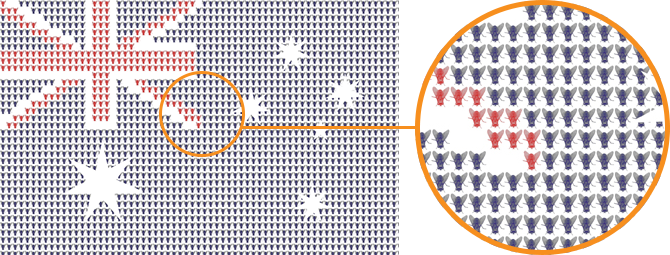Flying the Flag

The case for the adoption of a more relevant national creature
The image of a simple colonial society in which humans and kangaroos have learned to co-habit peacefully may still exist in
the minds of countless naive and ignorant Americans.
But the fact is that it is a gross and inaccurate misperception, fuelled by a pervasive and dishonest campaign to create the flattering impression that the kangaroo is an as vital and treasured part of everyday life as it is of the distorted national conscience.
It's true that hundreds of us do get close enough to these presentably furry marsupials to smash the life out of them with our shiny, unapologetically named 'roo bars'.
And many Aussie pet lovers do feed bits of packeted roo to their best friends.
But for the vast majority of contemporary antipodeans, the rodentlike long jumpers are nothing more than a comfortably benign and uniquely Australian symbol which looks good on coats of arms, coins, aeroplane tails, national brand logos and any number of items of kiche souvenir merchandise.
Forget that most farmers shoot them as pests, that our children are more likely to have tasted one than touched one, or that there are vast, heavily populated areas of the country in which they are as rare as the Tasmanian Tiger and famous Vietnam War veterans.
It’s not that the kangaroo is the only animal which occupies an undeservedly large plot in the national and international psyche.
The Koala, Platypus, Echidna, Possum and Wallaby have all benefitted from our keenness to use selected items of Australiana
as symbols of our friendliness, power and boundless charm and physical appeal.
The obvious but unrecognised reality is that there is one thriving icon of our national persona which is far more prevalent than all the cute and cuddly strangers venerated on our coinage and in our sanitised folklore.
It's the indefatigably friendly but uninvited guest at countless barbecues from Darwin to Port Dennison.
It's the quintessential egalitarian which has greeted assisted passage immigrants, pop stars and visiting heads of state (including our own occasionally), with identical enthusiasm and regard.
It's the small unignorable irritant which has distracted most of the nation's sporting greats.
Don Bradman, Rod Laver and Greg Norman have never had their powers of concentration challenged by an insistent kangaroo, an attention-seeking wombat or a thirsty koala, let alone had to wave them away at crucial moments of matches of international import.
No, there's only one creature which plays as great a role in the lives of country dwellers as it does in the day-to-day existence of city folk from every strata of society.
It's as pervasive and popular as advertising, influenza, sunburn and taxation and virtually every Australian spends time, effort and remarkably large amounts of money trying to avoid or destroy it.
It's the uncommonly influential common fly and, like it or not, it's done more to shape our way of life and form the national identity (of which the Australian Tourism Commission's overseas advertising only ever reveals carefully selected and polished glimpses) than any other non-human Aussie.
It's about time we stopped being ashamed of those elements of our Australianness which would have appalled our stuffy colonial
forebears and which still have the capacity to make our equally out-of-touch political masters cringe.
For goodness' sake, the fly is the fastest and most acrobatic creature in the massive and intensely competitive insect world.
It carries more germs on its leg hairs than there are marsupials living on our island continent.
It thrives (creating as many twenty-five generations in a single season) wherever in this often testing land Australian humans survive.
Like us, it is as happy eating rubbish as it is dining on the finest finger food high society has to offer. And its vision is as sharp (for distances up to 900 millimetres) as the vast majority of our nation's leaders, past and present.
So let's begin the move to get the fly into its rightful place in our minds and more honest national profile.
Let's start to recognise that the ubiquitous flyscreen is not simply an enduringly fashionable window treatment.
That the Australian 'salute' has nothing to do with our proud military past and high regard for authority.
That not every country in the world uses millions of litres of tomato sauce annually simply to disguise the taste of Mortein on
barbecued sausages.
And that, despite what the spin doctors misguiding Qantas might have us believe, there is no such thing as a bloody flying Kangaroo.
The only bits of kangaroo which actually remain airborne for more than a second or so are those lean cuts being freighted to the Sushi bars of Japan and the smaller samples which have been dissolved in saliva and sucked up the proboscis of the talented battler best credentialled to be our national creature.
The truly great, Australian fly.
Richard Clarke is the multi-award winning co-creator of Fly Art which can be viewed at www.flyartgallery.com and
leading galleries throughout Australia.
